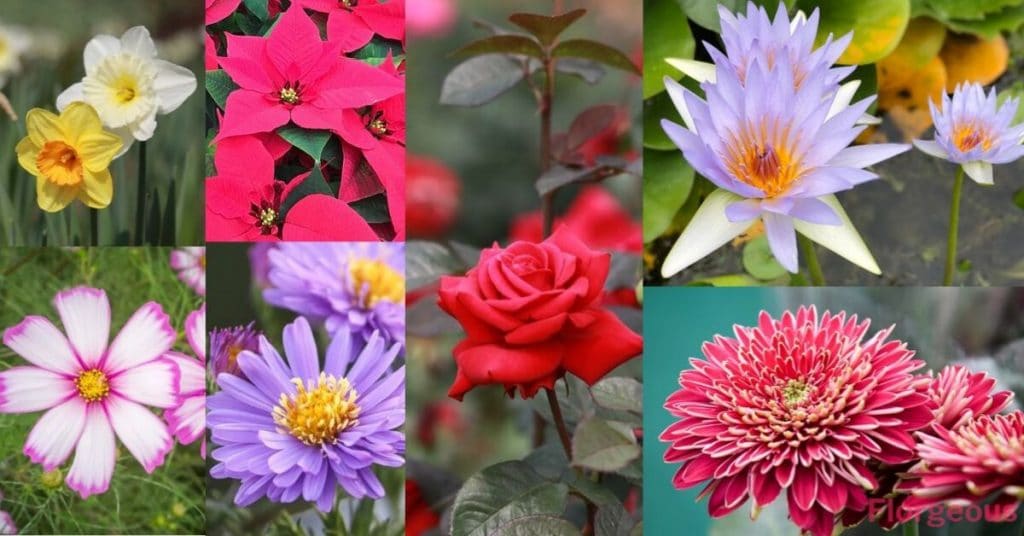When asked about what represents their birth month, most people would think about astrological signs and birthstones. But another interesting symbol is birth flower and some people are amazed to learn about these.
In this comprehensive guide, you will discover what the birth flowers for each month are, and what it says about you.
Like the zodiacs and gemstones, these flowers have their unique features and are believed to bestow certain characteristics to the individual born on their represented month.
Throughout history, significant flowers have been selected to represent the months of the year because of their botanical significance, the stories associated with them, and their connotations.
The use of flowers to convey messages have become a popular tradition, especially in England and America that they both developed their own styles and versions of flower meanings.
They say flowers are given as substitutes for words and to learn about birth flowers brings a whole new meaning to flower giving, making one appreciate the flowers and the loved ones they are given to even more.
January Birth Flower
Carnation
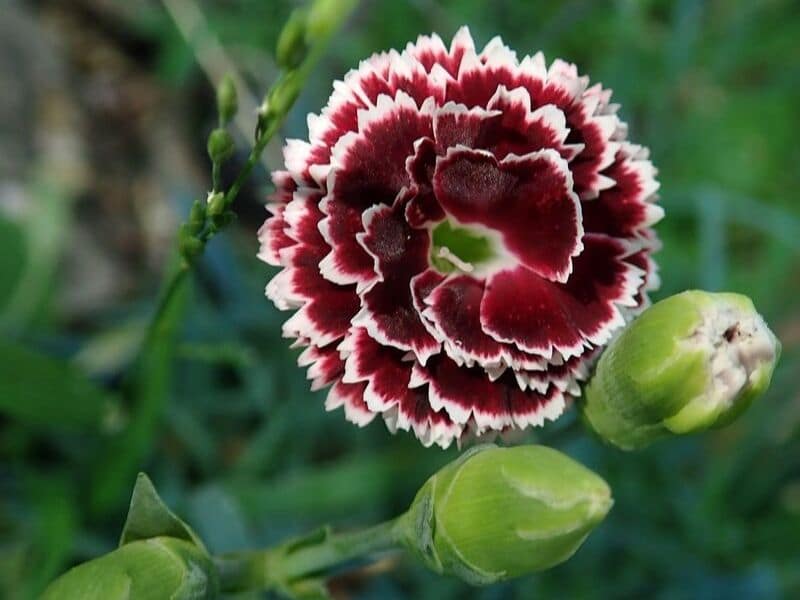
In the English version, carnation is the flower of people born in the month of January. It is one of the classic flowers popularly cultivated all over the world.
From the botanical family Caryophyllaceae, its scientific name is Dianthus caryophyllus from the Greek words “dios” and “anthos” and translates to “flower of the gods”.
The common name, carnation, may be attributed to “coronation” or “corone” since the flowers were used as garlands by the early Greeks and Romans (1).
The carnation plant is native to Europe and Asia and today, the world’s major areas of production are Colombia and China (2).
The three most cultivated kinds of carnations are annual carnations, border carnations, and perpetual-flowering carnations.
Carnations are perennial by nature but because of hybridization, they have developed an annual flowering habit producing continuous blooms especially in greenhouses.
Border carnations are generally planted in gardens and are the oldest carnation still being cultivated while the perpetual flowering carnations are the newest form.
Breeder William Sim developed the popular perpetual flowering carnations, the Sim series, which became the basis of varieties used in the international cut flower market (3).
The fringed and deeply-scented flower of carnation has different meanings and comes in various colors. In general, carnations mean distinction, love, and fascination. Red means admiration, white means pure love and remembrance, striped denotes regret or refusal while yellow is both cheerful and rejection.
There is a Christian legend that tells about how the pink carnation first appeared on earth. As Jesus carried his cross, the Virgin Mary cried and where her tears fell sprung pink carnations. From then on, pink carnations became a symbol of mother’s love and are worn on Mother’s Day (1).
Snowdrop
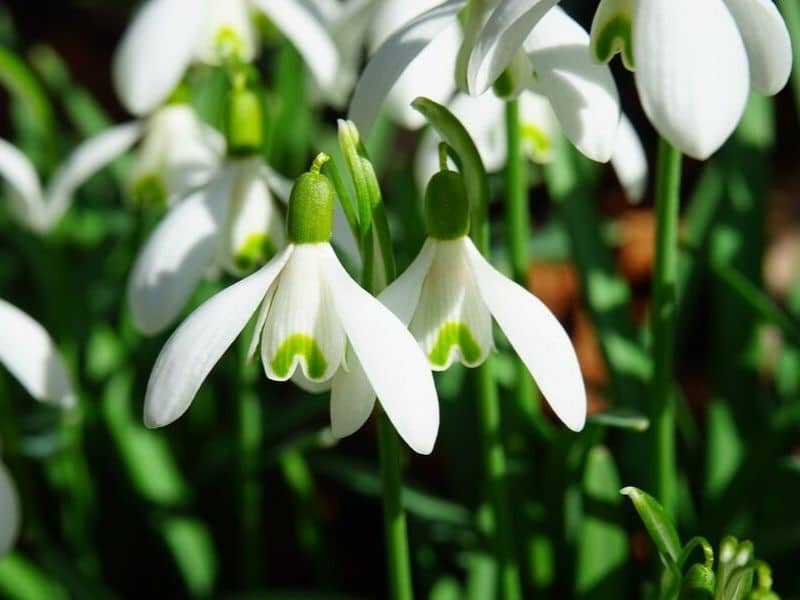
In the cold of winter, snowdrops are among the flowers that bloom that’s why the Americans associated them with the first month of the year. Snowdrops grow from bulbs, a known characteristic of the small family of Amaryllis.
The genus name, Galanthus, translates to milk flower referring to the flower’s color. The plant is native to Europe and Asia Minor and was widely used as a remedy to arthritis and digestive problems. The delicate flowers give the plant its charm and masses of this plant are grown to make gardens and pathwalks pop (4).
When it comes to symbolism of snowdrop, it is seen as the symbol of hope owing to the fact that they have the ability to bloom and make it through the harsh cold season. Because of its medicinal property to treat aches, the flower has become a symbol of courage and when given as a gift, it helps one create new opportunities for happiness.
A biblical story tells about the time when Adam and Eve were banished from the Garden of Eden. They were surrounded by barren land which made them weep and as God took pity, He sent an angel to sprinkle them with snow and where the snow fell grew tiny, delicate snowdrops (4).
February Birth Flower
Violet
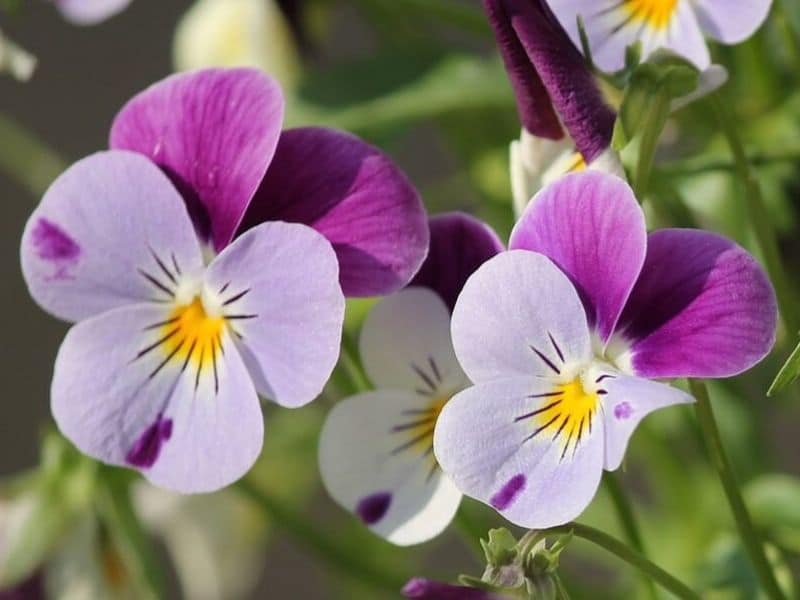
Although roses are given as gifts especially during Valentine’s Day, violet, in the English version, is the symbolic flower of February. According to a legend, St. Valentine favoured this flower and used the violet blossoms as ink to write love notes during his exile (5).
This flower belongs to the Violaceae family and the most popular species is scientifically known as Viola odorata. Another name for this plant is heart’s ease and in Shakespeare’s A Midsummer Night’s Dream, this flower was used to make a highly potent love elixir (6).
In reality, not much is known about its use as a love potion but violets have been proven effective in treating cough, asthma, and insomnia among others (7).
Violets are edible flowers as well which may be used in jams, teas, and salads. There are two main groups of violets known today.
The main group, pansies or horned violets (Viola cornuta) grow in temperate regions of the world. In areas of warmer climates, these violets often grow as perennial. They have a wide range of color and some have a light scent.
The Johnny-jumps (Viola tricolor), on the other hand, are annuals. The flowers are purple, white, and yellow hence, the name ‘tricolor’ (6). Violets thrive well in cool conditions and are popular as winter bedding plants (8).
In Roman Mythology, it was said that Venus had Cupid choose the prettiest between her and a group of cheerful girls. Mischievous Cupid chose the girls over her and in a rage, Venus beat the girls and then turned them into violets.
Since then, the Romans have associated violets with death and funerals but in the language of flowers, the violet’s symbolism includes romance, chivalry, and love. The purple hued violet connotes faithful love while the white color symbolizes candor, simplicity and innocence (9).
Iris
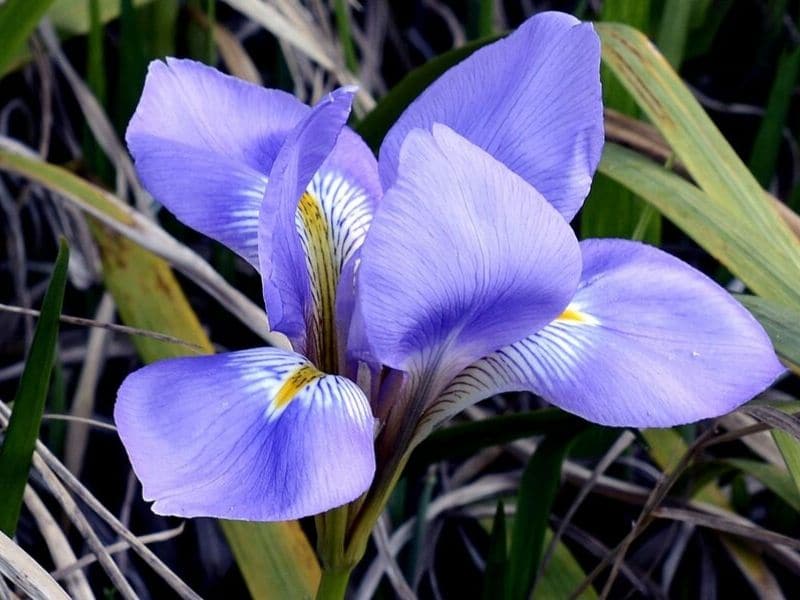
Iris is the name of the Greek goddess of the rainbow and is a fitting name to a plant that exists in various colors. The iris blossom is also regarded in England as the February flower pertaining to the purple Iris versicolor, a spectacular flower that blooms in spring.
The plant has a unique six-petaled flower, three upright called ‘standards’ and three that hang down called ‘falls’. It is believed that the three upright petals symbolize faith, valor, and wisdom (10).
Irises grow from special plant parts called corms and are mainly classified into three types: bearded, beardless, and crested. The bearded iris, I. germanica, got the name from the way the outer petals curl into a ruffled ‘beard’.
It is considered a hardy type and the easiest to grow. Beardless irises, I. sibirica, have smooth petals and thinner leaves while crested irises, I. cristata, are characterized by the orange or yellow ridges in the falls. Irises come in colors of yellow, pink, purple, and blue (10).
The meaning of iris flower is different in each country. It has been a symbolic flower all over the world. In Japan, irises are hanged to ward off evil spirits and misfortune and bouquets are given as congratulatory message.
Iris is also the national flower of France and the reference symbol of the Fleur-de-Lys insignia owing to a story where Clovis, the first king of France, was said to have found an iris in a swamp during battle which brought him good luck.
In Greece, purple irises were planted on graves to guide the dead in their journey to the afterlife (10).
Primrose
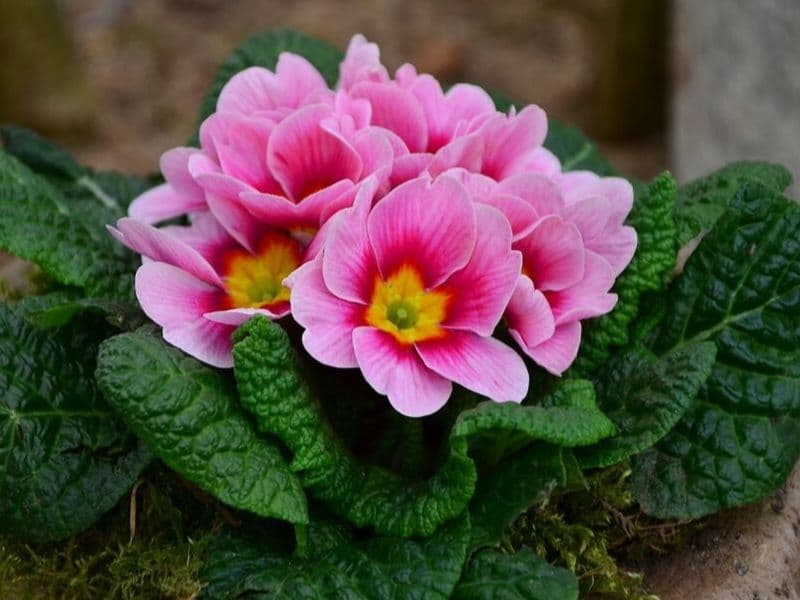
To the Americans, primrose is February’s blossom. The simple primrose is scientifically called Primula vulgaris. Its name translates to ‘first rose’ but the flower does not belong to the Rose family.
The name may be attributed to the flower being one of the firsts to bloom in spring. Native to Europe, primroses adorn European houses and parks as container or bedding plants (11).
Primroses have been extensively cultivated and numerous hybrids now exist. The successful breeding of this plant may be owed to the fact that primroses have naturally adapted and are inclined to cross-pollinate.
Their attractive flowers are classified into two types, the ‘pin-eyed’ where the female flower parts are more prominent and the ‘thrum-eyed’ where the male parts are more visible. These enable cross-pollination by insects which, in turn, produces more varied primroses.
The german folklore is rich with primrose stories and one legend tells of an enchanted castle with the doorway overgrown with primroses. When a mortal enters, the room becomes filled with gold and jewels covered with flowers and when the treasures are taken, the primroses must be put back or the mortal will forever be haunted by a black dog.
The primrose is the epitome of youth and young love. Receiving this flower means the sender cannot live without the receiver (12).
March Birth Flower
Daffodil

Daffodils are the yellow, droopy flowers of March to both English and Americans. They are ornamental plants grown from bulbs belonging to the family Amaryllidaceae originating from the Iberian Peninsula (13).
The wild daffodil is scientifically called Narcissus pseudonarcissus and is interestingly based on the Greek folklore about a man named Narcissus.
In the myth, Narcissus was a handsome young man who fell in love with his own image reflected on a pond. He waited by the pond for his image to come out of the water until he faded away with longing and in his place grew a plant with its flower drooping as if staring into the pond (13).
The distinguishing feature of daffodils is the corona commonly called the cup or trumpet (14).
This plant’s cultivars are grouped according to the type of this plant part. Butterfly types are those with split corona and are ruffled in appearance. The variety ‘Berlin’ is an example with yellow petals and orange center.
There are also double daffodils with double petals, double coronas or both. An example is ‘Replete’ with white petals and orange center (13).
Through hybridization, a lot more daffodil flower types have become available but it is important to note that despite being highly produced as cutflowers and as an ornamental plant, every part of the plant is toxic to humans, animals, and even other plants (14).
Perhaps the association of daffodils with the Greek mythology was the reason why to some, it connotes egotism and selfishness.
Although, this may also be the reason why daffodils symbolize domestic happiness and rebirth. The daffodils bloom in the spring, after the harsh winter and that in itself is a transformation of life (12).
April Birth Flower
Daisy
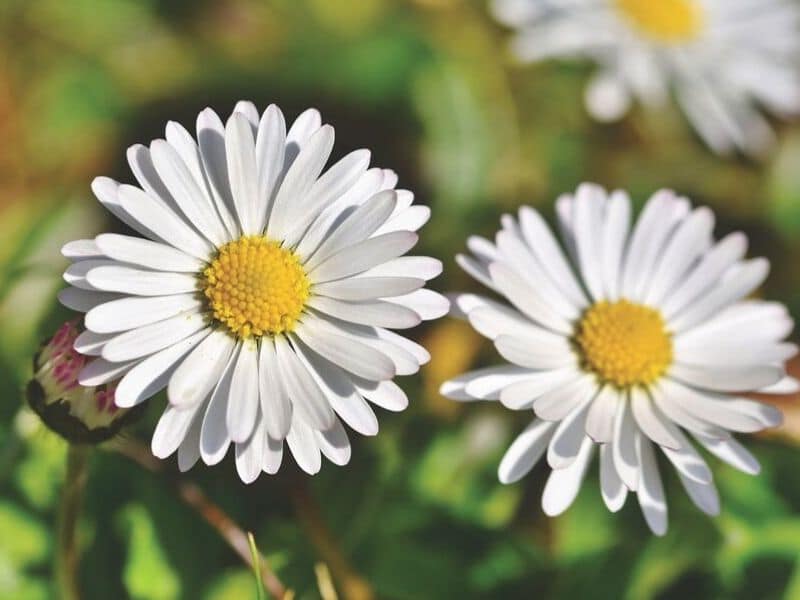
In England, April’s flower is the daisy. Its name was derived from ‘day’s eye’ for the way the flower opens up as the sun rises. These April birth flowers refer to the wide genus range of flowers from the family Asteraceae and the classic flower that represents daisies in most people’s minds is the white-petaled, yellow-centered Bellis perrenis.
Some say that the name Bellis was derived from the Latin word ‘bellus’ meaning pretty. Others say it’s from ‘bello’, the Latin word for war as the plant was used to treat wounds of soldiers in battlefields (15).
Daisy plant is native to Europe and Western Asia and aside from its medicinal function, it is widely used in flower arrangement and garden design. The daisy family is so big, there exist numerous kinds of daisies of varying colors.
The most common are: Shasta Daisy, bred by botanist Luther Burbank, with the same white petals and a noticeably larger yellow center, the Painted Daisy grown in gardens which attracts both butterflies and growers with colors ranging from purple to red, and the Gerbera Daisy most popular as a cut flower for its large flowers in bright colors of pink, red, yellow, and orange (16).
The daisy flower has beautiful meaning. It represents affection and purity and the popular children’s game, “He loves me, he loves me not” where they pluck the petals off a daisy flower while chanting the phrase is a tribute to this meaning.
Daisy superstition relates to babies and children as the flower means innocence as well. It is believed that it brings good luck for children to step on the first daisy flowers in the spring (17).
Sweet Pea
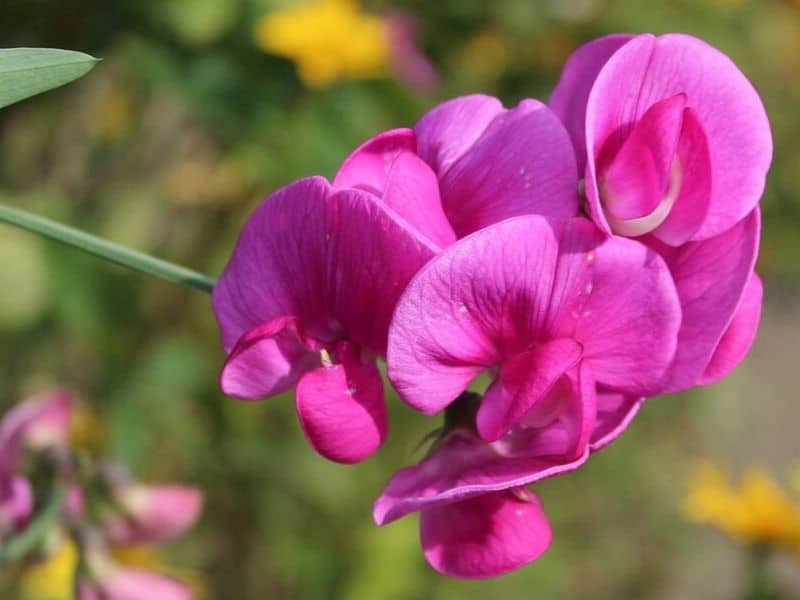
Sweet pea is a climbing flowering plant that made a name in the field of genetics because of its butterfly-like, appealing flowers and popular fragrant scent. To the Americans, this is the symbolic flower of April.
Sweet pea belongs to the Fabaceae family and was first discovered in Sicily (18).
The scientific name, Lathyrus odoratus literally translates to ‘very passionate fragrance’ attributed to the flower’s sweet scent and its prevalent use in perfumery. It is a common belief that sowing sweet pea seeds at the dawn of St. Patrick’s Day will result in the best production of this flower.
The common sweet pea was extensively studied and cultivated especially in the early 19th century. The horticulturist, Harry Eckord was greatly associated with the development of most cultivars that paved the way for sweet peas to be ornamentally recognized.
The ‘Henry Eckord’ sweet pea, named after the Sweet Pea King, has a dramatic bright orange flower well-received by plant enthusiasts.
In the language of flowers, sweet pea means pleasure. The flower color ranges from white to pink to yellow to blue and with the sweet smell wafted with the spring breeze, having them in the garden is a complete delight.
Sweet pea flowers are also given to a departing friend or loved one informing them of the great time the sender had with them (12).
May Birth Flower
Lily of the Valley
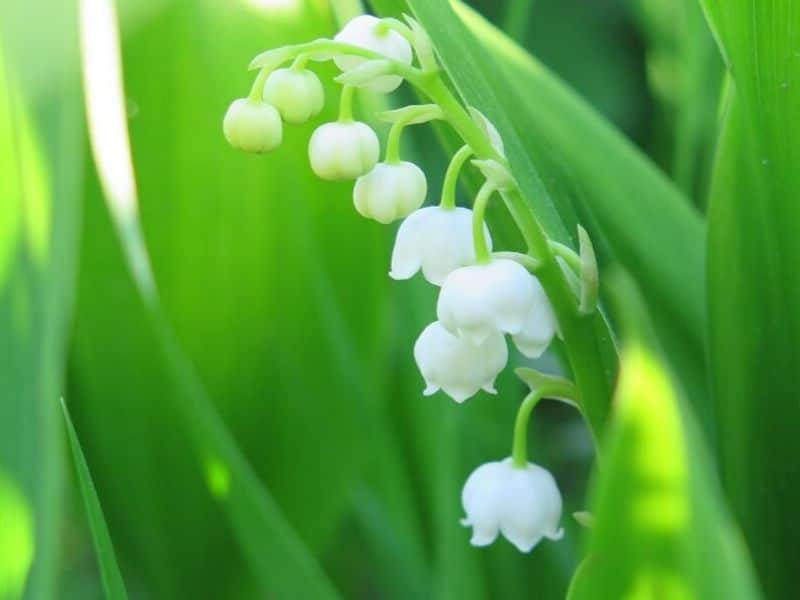
The sweet-scented Lily of the valley is also called Convallaria majalis which translates to ‘May Valley’ which, in England, is fitting as the symbolic flower of May. Not a true lily, this plant belongs to the Asparagus family and its distinct feature is the series of bell-shaped white, fragrant flowers.
Despite its sweet scent, the lily of the valley is among the highly poisonous plants and is described to be heart-arresting although when used and handled by professionals, it can ironically be effective as a botanical medicine (19).
Originating from the cold parts of Europe and Asia, the lily of the valley is an herbaceous perennial plant that grows and spread through its underground stems called rhizomes. There are two distinct varieties of lily of the valley, C. majalis majalis with white midribs on the flowers from Eurasia and C. majalis montana with green-tinted midribs from North America.
With its use as a cut flower and garden plant, qualities of some new lily of the valley have been improved. ‘Dora’ and ‘Rosea’ are both pink flowering varieties, while ‘Bordeaux’ is a variety of larger flowers and stronger stalks (20).
Lily of the valley symbolizes humility, chastity, and purity. Several captivating tales exist about the flower including how fairies use the flowers as cups to drink from and the goddess Maia whose son protected the flower.
There is also a story of a lily that wouldn’t bloom until her beloved nightingale comes back, to which the flower’s meaning, return to happiness, is probably in reference.
Because of its exceptional characteristics, the lily of the valley is celebrated in different parts of the world. It is the national flower of Finland and in France, the flowers are given during Labor Day (May 1) as an expression of good luck and appreciation (21).
Hawthorn
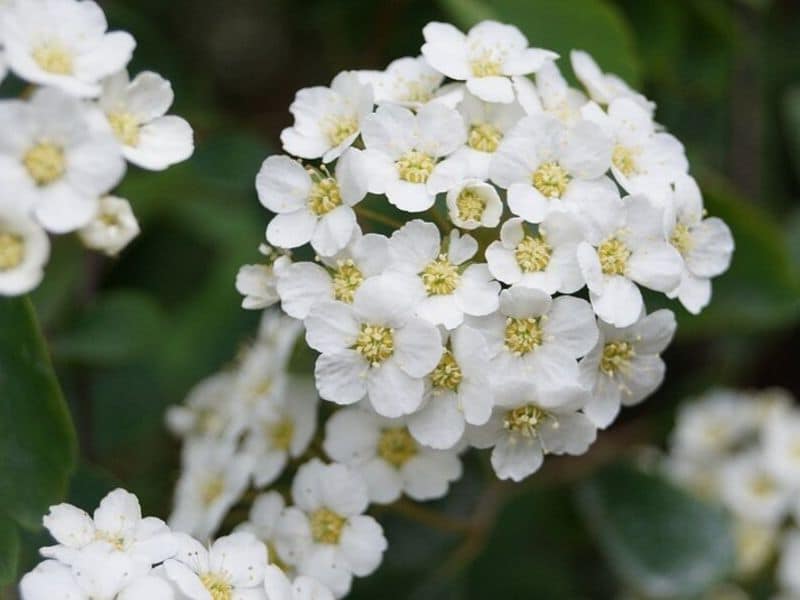
Hawthorn is the flower of May for the Americans. It belongs to the Rose family and has been cultivated for its economic use as food, medicine, and ornamentals. Like the roses, hawthorns grow as shrubs and have attractive flowers and leaves as well as the distinct thorns.
The scientific name of the common hawthorn is Crataegus monogyna derived from the hardiness of the plant wood and the single-seeded characteristic of the fruit.
Aside from the plant’s use as a hedge in the landscape, berry fruits are made into wine and leaves into tea which is effective in treating stomach and bladder problems.
Because of their thorny and hardy characteristics, hawthorns are cultivated as strong landscape plants. They can grow as high as 25 ft. and form thickets that can serve as a protective screen or barrier to private gardens as well as home to many birds and mammals. Two favourite varieties are the common hawthorn and smooth hawthorn.
The British believe that bringing hawthorn inside the house entails illness and death. Later, it was scientifically proven that a chemical produced by the hawthorn blossom is also formed in decaying animal tissues hence, its association with death. Despite this reference, hawthorn is a symbol of happiness and longevity as it can live for hundreds of years.
The hawthorn flower means sweetness and humility and an old rhyme tells about how young girls who bathe in dew gathered from the hawthorn blossoms will remain beautiful and young (12).
June Birth Flower
Rose
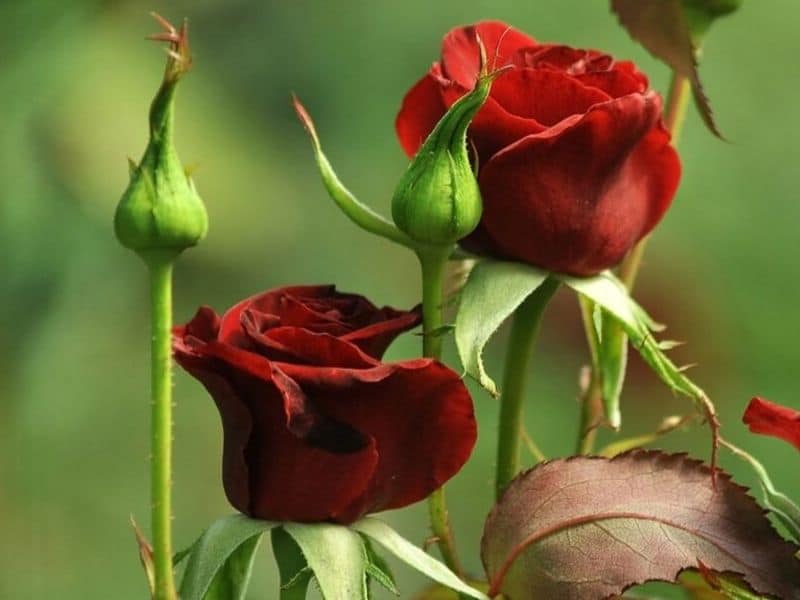
The lovely roses may be the most famous and established flowers and in America, they’re considered June birth flowers. Literature tells about its tales and history, breeders have been constantly growing superior varieties, and the demand for this flower all over the world has always been high.
Belonging to the large family of Rosaceae, there are many types of roses and this flower is said to have gotten its name from the Goddess of Love, Aphrodite, who named it after her son, Eros (22).
In the northern hemisphere, roses bloom in spring when temperatures are permissive. The flowers are abundant in June and this is probably the reason why it is considered the month’s flower (23).
Roses are believed to have originated from Central Asia and have been cultivated since 5000 years ago.
Today, more than 40 types of roses are identified and they are classified into two groups, Heirloom Roses and Modern Roses. Heirloom Roses are those that existed before Modern Roses were introduced in 1867. They are fragrant roses from Europe like the ‘Albas’, ‘Bourbons’, and ‘Galicias’ which only bloom once in a season.
In the 1800s the China and Tea Roses from Asia were introduced and crossbred with Heirloom Roses giving birth to the colourful Modern Roses which can bloom more than once, the ‘Hybrid Tea’, ‘Floribundas’, and ‘Grandifloras’ (22).
Although the symbolism for roses varies with color, the flower is generally associated with love and beauty. Red roses mean passion and white roses symbolize purity.
In English history, the red rose was the insignia of House Lancaster who battled House York, the white rose, for the throne. In the end, it was Henry Tudor who ended the war and invented the national floral emblem, Tudor Rose and united the two previous houses (24).
Roses are truly special even Shakespeare wrote, “Of all flowers, methinks a rose is best.”
Honeysuckle
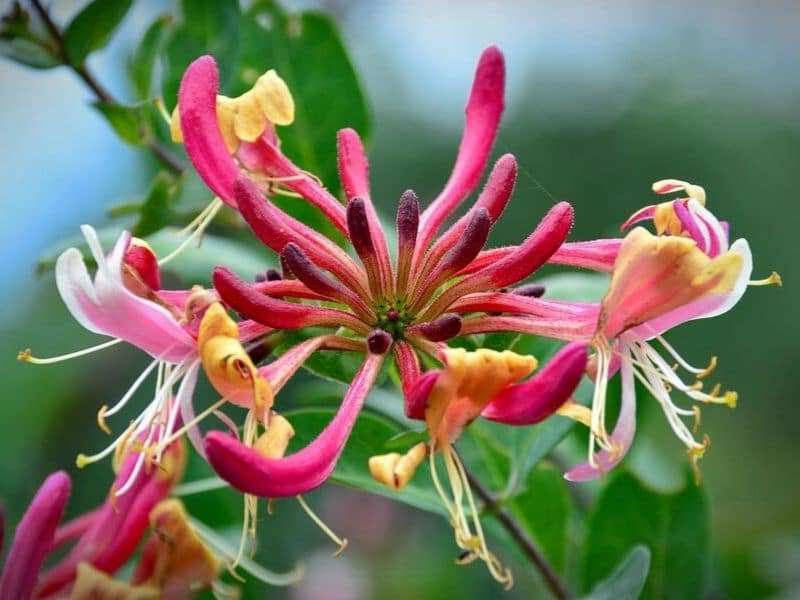
The honeysuckle pertains to the flowering plants of the Caprifoliaceae family native to Europe, Asia, and North America and its flower is considered in England as symbolic of the month of June.
The most common species is the Lonicera periclymenum and the genus was named after the German botanist, Adam Lonicer.
The common name, honeysuckle, may have been derived from the children’s tendency to pick the blossom and suck out the sweet nectar from the tubular flowers.
Honeysuckles are great landscape plants because of their showy flowers and their fast-growing characteristics which help hold the soil, preventing erosion (25).
Honeysuckles exist in shrub and vine forms. The shrub type, L. fragrantissima is excellent as a hedge and as a potted plant and the creamy-white flowers are strongly fragrant too. The vine type, L. japonica twines itself to sturdy structures and is just as marvellous but its dense growth tends to crowd other plants that the plant is considered invasive.
Growing them must be controlled and overgrowths should be removed by hand pruning or by using systemic herbicides (25).
Honeysuckles are well-loved for their beauty but this plant has a distinct association with witches. It is believed that witches use the twisted honeysuckle twigs in rituals to prevent women in labor from giving birth. They also wear honeysuckle wreath as protection (12).
Regardless of the negative connotation, honeysuckles generally symbolize sweet life and everlasting love. Receivers of this flower are meant to have good luck and true love (21).
July Birth Flower
Water lily

Water lilies are unique, beautiful ornamental plants that live in water and they belong to the family Nymphaeaceae. It is said that the name was derived from Nymphe, the Greek goddess of the waters (26).
The plant has evolved through time to adapt to the environment–they have formed big leaves for photosynthesis and weak stems to easily float on water. To the Americans, water lilies are July birth flowers.
These aquatic plants are either perennial or annual. Perennial water lilies are hardy and are the result of crosses from the European and North American species. Their blooms float on the surface of the water and they can even survive through winter.
Annual or tropical water lilies mostly came from Asia. They are kept dormant during winter and their fragrant flower usually rises above the water. Some popular water lily species are N. mexicana, N. elegans, and N. odorata (26).
Symbolism of water lily include happiness, purity and divine birth. The flower’s habit of closing at night and reopening in the morning is the Hindu’s representation of resurrection while the water lily’s ability to bloom from the mud is a symbol of enlightenment for Buddhists.
For the Chinese, the use of water lilies in weddings symbolizes a happy union lasting for 100 years (21).
Larkspur
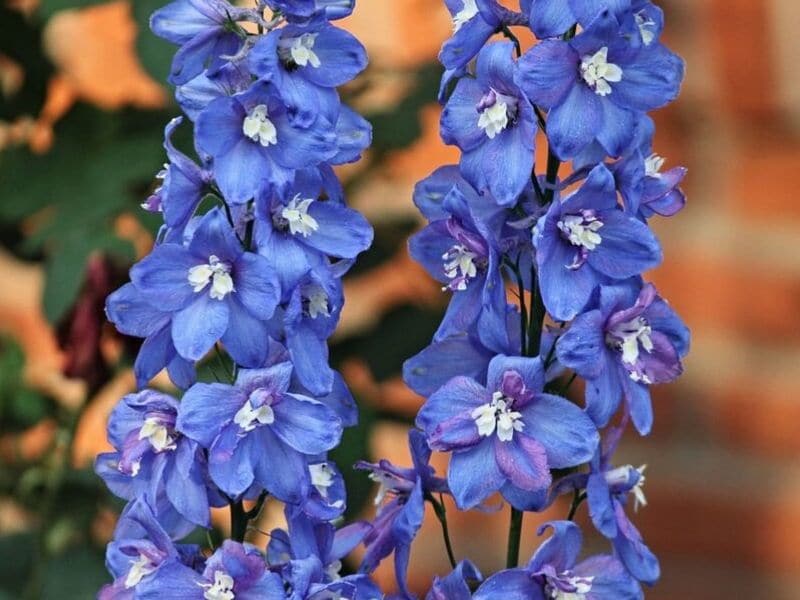
Larkspurs are flowering plants characterized by an arranged floral formation on an airy stalk. The plant belongs to the Buttercup family and is native to the Northern Hemisphere (27).
The shape of the flower’s bud resembles a dolphin and is regarded as the reason behind the genus name, Delphinium. The common name, larkspur, on the other hand, was derived from the flower’s resemblance to a lark’s claw. In any case, the colorful flower is always a favourite summer blossom that in England, larkspur is considered July’s flower.
There are two natural types of larkspur, the ‘belladonna’ and the ‘elatum’. Belladonnas are small and their flower pedicels are usually loose and upright. These are mostly used as fillers in bouquets.
Elatums are large with tall spikes and bigger flower heads (27). This species is a favourite among florists since it is one of the few flowers with natural blue color.
An old legend tells about a goddess ripping open the sky and scooping a portion of it to turn into a spike. She plunged it down the earth and small blue specks of the sky adhered to it which turned into the larkspur flower. This brought the lightness and levity meaning to the plant which is fitting for its summer bloom (21).
They say that the horned-shape of the larkspur flowers repel scorpions, ghosts, and evil spirits that they are hung above doors. In the floral language, white larkspur signifies being carefree and purple means first love.
See more: Larkspur flower meaning and symbolism
August Birth Flower
Gladiolus
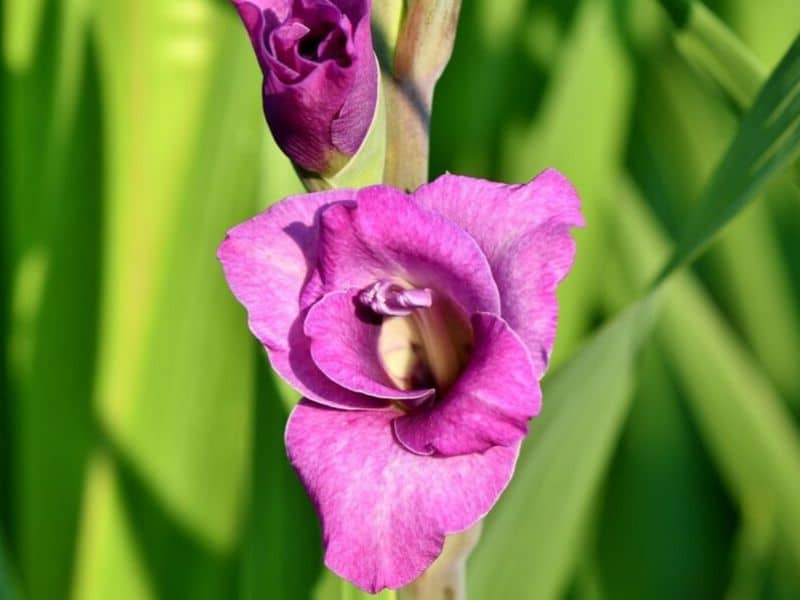
The gladiolus belongs to the Iridaceae family. The flower’s name came from the Latin word gladius meaning sword which is attributed to the plant’s sword-like leaves (28).
There is an old saying, ‘death or gladioli’ which is reminiscent of the ancient practice of showering gladiators who won battles with gladiolus petals. In America, this is the flower of August.
The largest genus in the Iris family, gladiolus are said to be native to Tropical Africa. Some of the most popular gladiolus are ‘Yellowstone’ with tall, bright yellow flowers, ‘Claudia’ with yellow-centered crimson red flowers and the ‘Alaska’ with flower head lined perfectly with white florets. Other varieties come in bold and mixed colors in different flower forms.
A story of how this delicate-looking flowers came to be was about two brothers who fought each other for the love of a young woman. They drew their swords and fought but they both died and where they were laid grew two gladiolus with flowers as red as blood. From this came the flower’s meaning, honor, and strength.
In the language of flowers, gladiolus means infatuation indicating that the receiver has pierced the sender’s heart (21).
Poppy

The common poppy is scientifically known as Papaver rhoeas meaning ‘red milk’ since the plant produces milky sap, a characteristic of species under the family Papaveraceae, and red is the color of the common poppy flower.
Because of how easy they are to disperse, poppies can cover large areas of land but they are too pretty to be considered as weeds and fields flowing with these red flowers are always a sight to see.
The poppies originated in the Eastern Mediterranean where they are part of a rich culture and history. The two most popular species are the common poppy, P. rhoeas and the opium poppy, P. somniferum.
Although both species have medicinal values, common poppy was more widely used as a food ingredient and as landscape plant while the opium poppy became more important as medicine because of the potent sap obtained from it (29).
There is an old tradition for young girls where a poppy petal is placed on the palm of the hand and then slapped. If it burst and made a noise, the puppy love is true and sincere but if there was no sound, it is the opposite (12).
Poppy seeds can remain dormant under the soil for over a hundred years and will only germinate when disturbed to receive light. During World War I, bombings, trench digging, and mass graves disrupted the soils of Europe causing the poppies to bloom, a beautiful sight given a different circumstance.
Poppy flower meaning may vary depending on where you live. To commemorate the lives lost during WWI, poppy necklaces were worn (29). This may also be why the poppy became a symbol of silence and consolation and the symbolic flower of August in England.
September Birth Flower
Aster
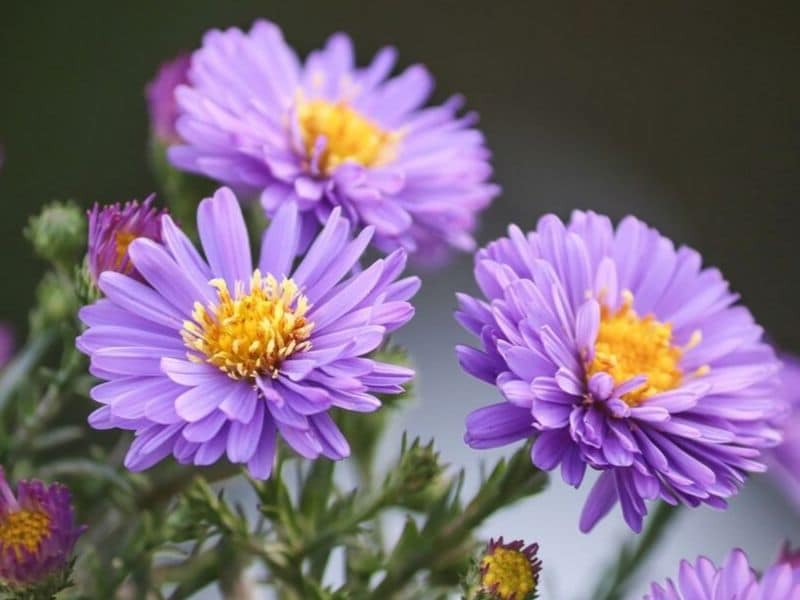
Aster is the Greek word for stars and it also refers to the dainty flowers of the Asteraceae family. One legend tells about the goddess Asterea who cried when she saw that the night sky was empty of stars. Where her tears fell grew asters with petite star-like flowers.
In England, asters are September birth flowers since the aster plants prefer the cool autumn breeze and are in full bloom during this month. They are normally used as bouquet fillers, compact borders for gardens, and some are used in teas as a treatment to stomach ache and fever (16).
Majority of the 600 species of aster are native to North America. They are divided into two types, the New England and the New York asters. New England asters are tall and hardy, with compact and full blooms in red, pink, purple, and white. They bloom earlier, usually in mid to late summer.
The New York asters which flower late summer to early fall are shorter and the stems are thinner with blooms mostly purple. Despite their physical differences, both species are perennial in growth and are easy to maintain (16).
Asters generally symbolize fidelity and wisdom. Yellow asters are said to make one’s day optimistic, blue asters bring calmness and stability, and white asters symbolize new beginnings.
The aster flower is also said to be a talisman of love that when lovers exchange this flower, they are bound to have a lasting relationship (21). This flower is used in celebration of St. Michael’s feast on September 29.
Morning Glory
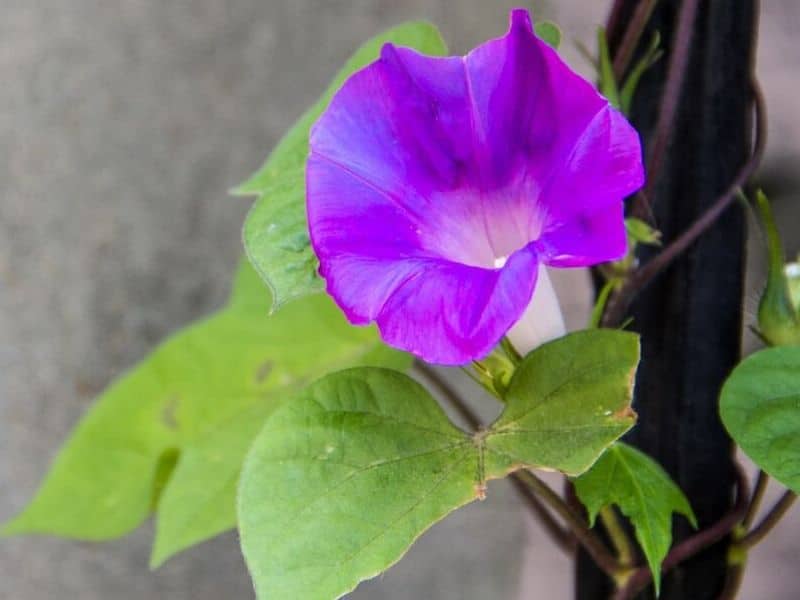
Morning glory refers to the plants that belong to the Convolvulaceae family which when translated, means twining or trailing – a defining growth habit of morning glories. The morning glory, referred to as September flower in America, is the Ipomea purpurea which is native to Mexico and Central America.
They are vines that have heart-shaped leaves and funnel-shaped flowers usually in shades of purple or blue. The flowers are ephemeral but they are lovely plants that can quickly cover garden areas by entwining themselves to the ground and sturdy structures (30).
Today, there are over 1000 types of morning glories identified. The ‘Moonflowers’ have big, iridescent white flowers that bloom all night long. The ‘Water Spinach’ is an Asian species used in many culinary dishes. The Ipomea batatas grow a potato-like tuberous root that is edible as well.
Although most of them are cultivated for their stunning flowers, many are grown as food, especially the Asian varieties. In fact, many species are utilized in creating edible landscapes (30).
Morning glories signify love and affection (21). The ephemeral flower only lasts a day and in a Chinese folklore, this signifies a day lovers can meet. The morning glory is also a nod to every brand new day that is God’s gift of glory.
October Birth Flower
Marigold
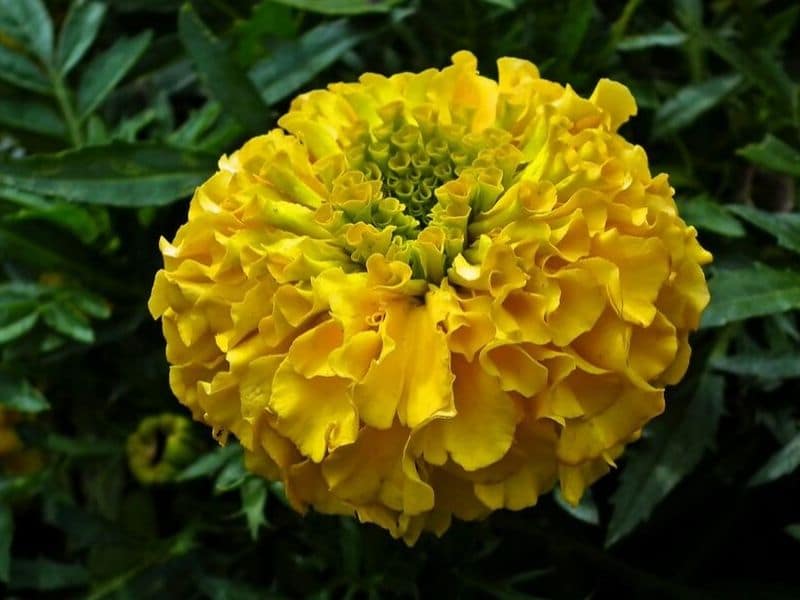
Marigolds refer to the two separate species, Calendula officinalis and Tagetes erecta (31).
They are mainly decorative plants than can also be used as medicine and culinary ingredient but they were significant in the religious history of the Christians and the Aztecs.
The name, the shortened version of Mary’s Gold, was inspired by the Virgin Mary. It was believed that Mary used the flower head in lieu of money to buy food. In England, marigolds are October birth flowers.
Marigolds also belong to the Aster family and trace their roots to the Americas. As the name suggests, these flowers are yellow and orange in color and they are classified into four types.
The ‘French Marigolds’ are sturdy plants growing from fall to summer. They are good garden and potted plants with flowers in yellow and orange and a slight touch of maroon. The ‘Signet Marigolds’ are edible and are commonly used to add color to salads. The yellow flower formation is a single row of florets.
The ‘African/Aztec Marigolds’ have big blooms that are more often used in flower arrangement. The flowers almost look like the French variety except they are larger.
Finally, the ‘Triploid Hybrid’ is a cross between the French and Aztec marigolds and the big, bright orange blossoms are perfect in gardens and in bouquets (31).
When it comes to meaning and symbolism of marigold flower, to the Aztecs, marigolds are sacred and are used to decorate temples but when the Spaniards conquered their empire, the flower was given a whole new meaning. They became the representation of the blood of the Aztecs splashed over the gold that the Spanish stole.
In today’s Mexican tradition, marigolds are referred to as flor de muerto (flower of death) and they represent grief and pain. On a lighter note, marigolds are the epitome of passion and creativity. They are used as colourful garlands offered in altars and temples (12).
Cosmos
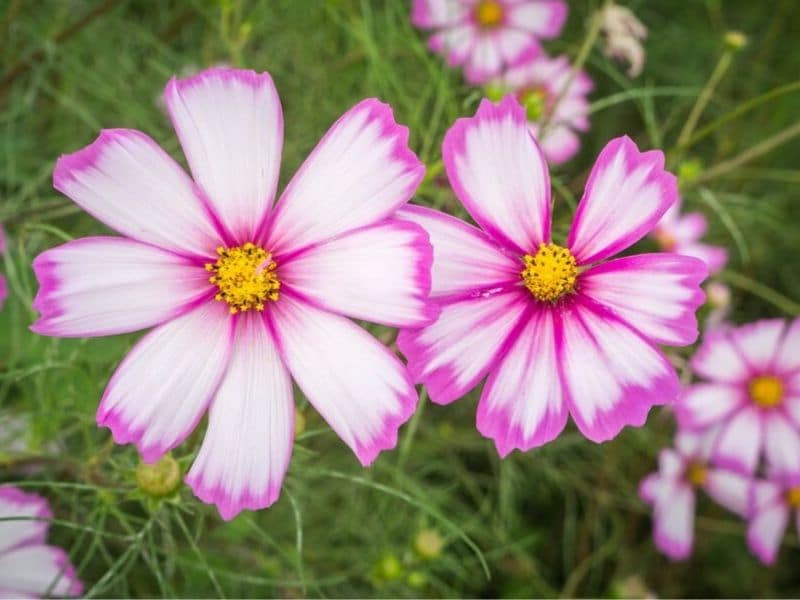
Cosmos plants are native to Mexico and according to Americans, they are October’s blossom. Spanish priests grew them in their mission gardens and named the plant Cosmos for the reason that the petals are arranged in a harmonious order (32).
The most common species is the C. bipinnatus, a member of the Aster family and the flowers usually come in red (Rubenza), pink (Antiquity), or white (Sonata White), always with a yellow center. The colourful flowers and the slender stems are widely appreciated that they became popular as landscape plants.
Another species, the C. sulphureus, just as charming and graceful, is known as one of the common mosquito repelling plants in tropical countries. This species is more famous for the yellow, orange, and red colors.
As the name suggests, cosmos flowers represent balance and orderliness. They say that giving a bouquet of this flower to a special someone relays the yearning to walk hand in hand and share the abundant love with each other (21).
November Birth Flower
Chrysanthemum
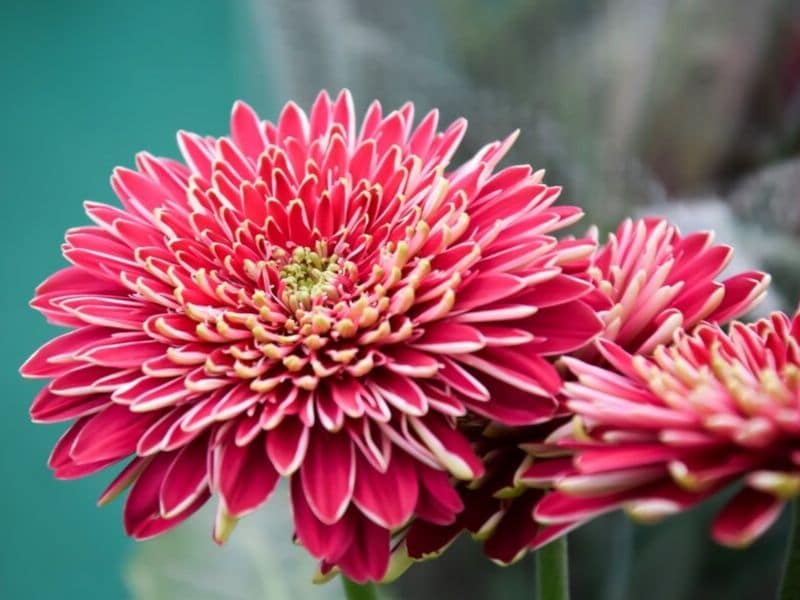
The chrysanthemum or mum is one of the most important ornamental crops in the world. It was first cultivated in China and was later introduced to Japan and Europe.
Chrysanthemums are very popular as potted and garden plants and more so as to cut flowers. From the Greek words ‘khrusos’ or gold and ‘anthemon’ or flower, chrysanthemums originally come in yellow and white colors but now exist in many different forms (33).
In England, mums are symbolic of the month, November.
Chrysanthemums are so popular and extensively cultivated that there exist many classifications. Single mums, like the ‘Amber Morning’, are flat-centered with five rows of petals. Pompom mums are small, globe-like flowers as seen in ‘Baby Tears’ and ‘Pixie’.
Anemone mums like the ‘Sunbreak’ have raised center, surrounded by short and darker petals. There is also the Spider mum like ‘Anastasia’ which got its name from the long petals that look like a spider on top of the stem (33).
In Japan, the monarchy is called the Chrysanthemum Throne and their emblem is the mum blossom. They have a legend about a town whose people lived for a hundred years as they drank water from a mountain spring surrounded by chrysanthemums.
Despite this long lasting connotation, the November flower is associated with the dead and are given during funerals. But chrysanthemums also symbolize cheerfulness and optimism probably since they bring joy with their abundance during the cold season (34).
Peony
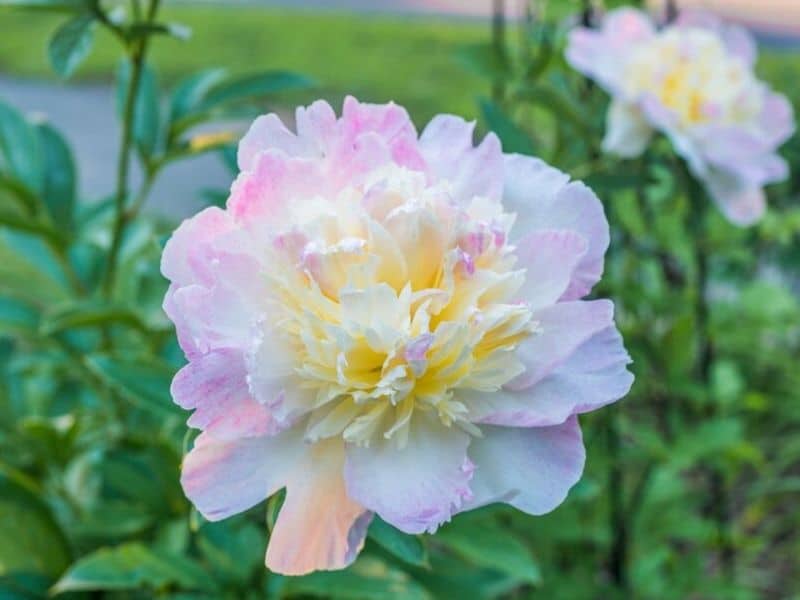
The common peony or Peonia officinalis is among the thirty three identified perennial plants under the family, Paeoniaceae (35).
Peonies are known for their long-lasting, colourful blooms and have been a favourite flower through centuries. The plant is native to China and because of its popularity, the peony is referred to as the ‘King of Flowers’.
Peonies were not always propagated as ornamentals in the ancient times, though. They were initially grown as medicinal plants used in making tea drank by women who just gave birth. In America, it is considered the flower of November.
Peonies can be herbaceous, tree type, or intersectional. Herbaceous peonies are low-maintenance plants that bloom from May to June and the flowers last for 7-10 days.
Tree peonies bloom in May with flowers lasting for 14 days. The intersectional peony is a hybrid between the two and can produce 30-50 longer-lasting blooms per plant, usually for 3-4 weeks (35).
Many stories are associated with the peony flower meaning. In Greek mythology, there was a beautiful but shy nymph, Paeonia, who caught the attention of Apollo. As they interact, Aphrodite became jealous and turned the nymph into a red peony.
The flower also emanates the moon, glowing at night and chasing away evil spirits to protect the house close to where the plant grew (12). All these made the peony flower the symbol of bashfulness (21).
December Birth Flower
Poinsettia
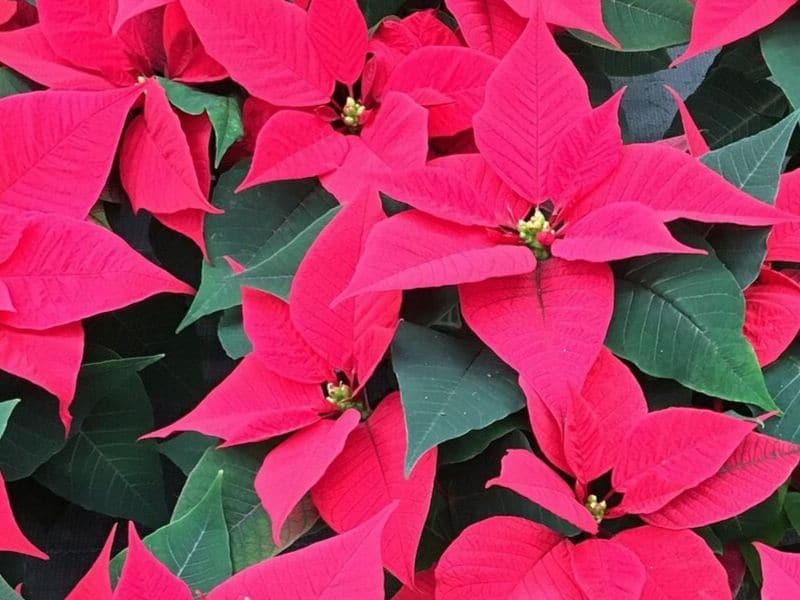
Poinsettia is the unique flower of Christmas with its striking color and extravagance. English people think of it as the flower of December. Joel Roberts Poinsett, a US Ambassador and botanist introduced the plant from Mexico to America where the flower gained popularity.
Although named after the American botanist, the poinsettia is scientifically known as Euphorbia pulcherrima which translates to ‘most beautiful euphorbia’. The red petal-like parts which make the plant enchanting are actually modified leaves called bracts (36).
Poinsettias are short-day plants, they only need a maximum of 10 hours of exposure to daylight and they prefer cold temperatures to keep the famous red hue, but poinsettias today exist in different colors.
Pink was the first non-red color of the plant followed by white. They now also come in speckled colors, curled bracts, and bigger sizes.
These December birth flowers represent success and celebration. Often used to decorate for the holidays, the poinsettia is a symbol of celebration of the past months and an eagerness to the start of a fruitful new year.
For Christians, the poinsettia is representational of the Star of Bethlehem and the red color is a reminder of Christ’s blood shed for man’s salvation (36).
Holly

The iconic holly produces one of the flowers or fruits of great religious significance. It is America’s symbol for the month of December. Also called Ilex aquifolium, holly is an evergreen shrub known for its glossy, needle-like leaves and red berries.
It is a dioecious plant with the male and female flowers existing in separate plants, so some plants will not have the striking berries. Other species are deciduous which means they shed their leaves and become bare in the fall as an adaptation to the coming winter season (37).
Hollies are native to North America and before their association with religious practices, the plants were used as medicine. A dark tea from the leaves induces bowel movements and vomiting.
The Christian tradition of decorating churches with holly originated from the Roman’s practice in celebration of the Festival of Saturnalia. Sending holly sprigs to friends wishes them good health and well-being.
With its evergreen characteristic, the ability to endure the winter season, the holly symbolizes Christ’s resurrection. It also connotes life and creativity during challenging times (37).
Narcissus (Paperwhite)
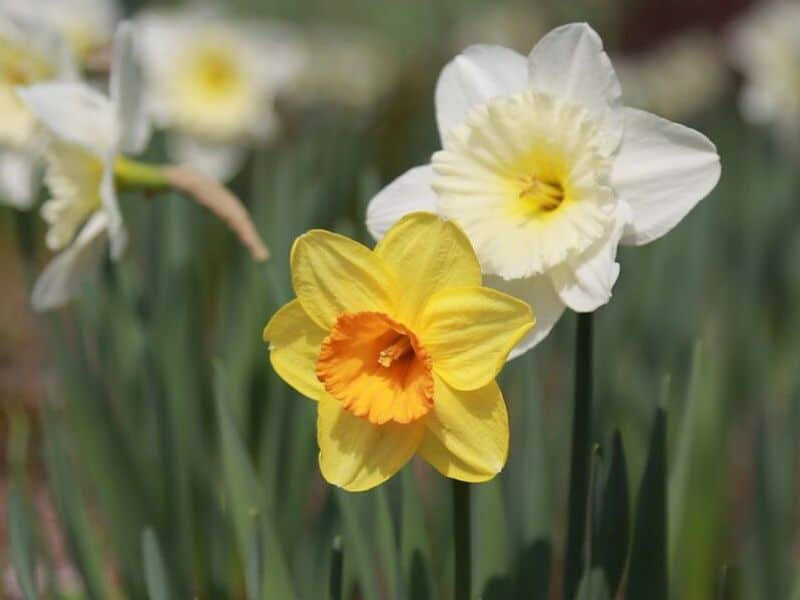
The paperwhite or the white narcissus is also one of the official symbols of December for the Americans. Like the daffodils, paperwhite plants belong to the amaryllis family and the scientific name Narcissus papyraceus is attributed to the paper-like characteristic of their flowers (38).
Because of the Greek story of the vain Narcissus, the flower is associated with self-esteem and vanity. As the birth flower of December, it signifies faithfulness and respect and a symbol of high spirits during the holidays (21).
FAQs
Why are there two birth flowers for each month?
Having two birth flowers for each month is often rooted in historical and cultural traditions. These associations may be based on zodiac signs, historical practices, or the availability of flowers during specific times of the year, adding a unique and diverse element to the concept of birth flowers.
How can I identify my flower?
To identify your flower, start by observing its key features such as the shape and color of the petals, the arrangement of leaves, and the overall plant structure. Utilize plant identification guides, online databases, or seek assistance from local botanical gardens or horticultural experts for accurate identification.
References
References List:
(1) Perry, Leonard. Carnations-A Classic Cutflower. The Green Mountain Gardener. 2016.
(2) Onozaki, Takashi. “Breeding of Carnations (Dianthus caryophyllus L.) for Long Vase Life.” Breeding science. Vol. 68. No.1. 2018. Pp 3-13. link.
(3) Department of Health and Ageing (DHA), Office of Gene Technology Regulator, Australian Government. The Biology and Ecology of Dianthus caryophyllus L. (Carnation). 2005.
(4) Mahr, Susan. “Snowdrops, Galanthus spp.” Master Gardener Program. 2007.
(5) Beredjiklian, Norma. “St. Valentine’s Violets.” The Violet Gazette. Vol. 2. 2001. P.7.
(6) Perry, Leonard. Versatile Violas. The Green Mountain Gardener. 2007.
(7) Asheesh, Kandpal. “A Brief Knowledge of Banafsha (Viola odorata Linn) and Other Viola Species.” International Journal of Ayurveda and Pharmacological Research. Vol. 5, No. 4. 2018. Pp 73-74.
(8) Gill, Dan. “Pansies, Violas Make Ideal Winter Flower Gardens.”LSU College of Agriculture. 2016. link.
(9) Chwalkowski, Farrin. “Symbols in Arts, Religion and Culture: The Soul of Nature.” Cambridge Scholar Publishing. 2016. Pp. 226-228.
(10) Wall, Dora. “The Iris Legend.” American Iris Society. Vol. 196. 1970. P. 124.
(11) Boland, Todd. “Primrose Selections for Newfoundland.” The Quarterly of the American Primrose Society. Vol. 63. No.4. 2005. P. 25.
(12) Watts, D.C. “Dictionary of Plant Folklore.” Elsevier Science Publishing Co. Inc. 2007.
(13) Kandeler, Ricklef and Ulrich, Wolfram. “Symbolism of Plants: Examples of European-Mediterranean Culture Presented with Biology and History of Art: February: Sea-daffodil and Narcissus.” Journal of Experimental Botany. Vol. 60. No. 2. 2009. Pp. 353-355. link
(14) Hanks, Gordon. “Narcissus Manual.” Agriculture and Horticulture development Board. 2013. Pp. 9-10.
(15) Al-Snafi, Ali. “The Pharmacological importance of Bellis perennis – A review.” International Journal of Phytotherapy. Vol. 5. 2015. Pp. 63-69. link
(16) Rauh, Dick. “The Aster Family.” The Botanical Artist. Vol. 13. No. 4. 2007. Pp. 7–7.
(17) Kell, Katharine T. “The Folklore of the Daisy.” The Journal of American Folklore, vol. 69, no. 274, 1956, pp. 369–376. JSTOR, link.
(18) Nakamura, Kaoru, et.al. “Genetic Variability of Morphological and Cultural Characteristics in Sweetpea (Lathyrus odoratus L.).” Japan Society of Horticultural Science. Vol. 79. No. 2. 2010. Pp. 179-191. link
(19) Romm Susun, Aviva, et. al. “Botanical Medicine for Women’s Health.” 2010. Pp. 455-520. link
(20) (eFloras.org). Flora of North America. Vol. 26. 2015. Pp. 53-56.
(21) Stewart, William. “Dictionary of Images and Symbols in Counseling.” 1998. Pp. 350.
(22) Trinklein, David. “Rose: A Brief History.” 2018.
(23) Bendahmane, Mohammed, et.al. “Genetics and genomics of flower initiation and development in roses.” Journal of Experimental Botany. Vol. 64. No. 4. 2013. Pages 847–857. link
(24) Touw, M. “Roses in the Middle Ages.” Economic Botany. Vol. 36. No. 1. 1982. Pp. 71-83. link
(25) MacDonald, Greg, et al. “Invasive Species Management Plans for Florida.” University of Florida, Department of Agriculture and Consumer Services. 2008. Pp. 170. link
(26) Trinklein, David. “Water Lilies: Easier Than You Think.” 2017.
(27) Verges, Cesar Blanche. “Delphinium L. Subgen. Delphinium: Origin and Evolutionary Trends. 1990.
(28) Susaj, Lush. et.al. “Gladiolus (Gladiolus spp.)-An Important Plant of Wild and Cultivated Flora in the Central Part of Albania.” International Conference, Albania. Vol. 1. 2012. Pp. 240-245.
(29) Krupnik, Gary. “100 Years Ago, Poppies Became More Than Just Flowers.” National Museum of Natural History. 2018.
(30) Fang, Z. et.al. “Tracing the Geographic Origins of Weedy Ipomoea purpurea in the Southeastern United States.” Department of Agronomy and Plant Genetics. Vol. 104. No. 5. 2013. Pp. 666-777. link
(31) Kaur, Komalpreet and Kaur, Ramninder. “Marigold: Beyond Beauty and Décor.” American Journal of Phytomedicine and Clinical Therapeutics. Vol. 1. No. 5. 2013. Pp. 480-485.
(32) Gilman, Edward and Howe, Teresa. “Cosmos bipinnatus.” FPS. University of Florida. 1999. P. 1-3.
(33) Taylor, Judith. “History of the Chrysanthemum.” History and Development of the Modern Chrysanthemum. 2013.
(34) Lombardi, Linda. “Chrysanthemums are more than Just a Symbol of Autumn.” 2014.
(35) Dana, Michael and Lerner, Rosie. “Peonie: State Flower of Indiana.” Department of Horticulture, Purdue University. 2001. link
(36) Sterkenberg, Zack. “The Long, Strange Tale of the Poinsettia in Christmas Lore.” 2016.
(37) Barstow, M. & Khela, S. Ilex aquifolium. The IUCN Red List of Threatened Species. 2018.
(38) Barrales, Rocio, et.al. “Geographic Variation of Flower Traits in Narcissus papyraceus (Amaryllidaceae): Do Pollinators Matter?” Vol. 36. No. 7. Pp. 1411-1422. link
Photo credit: Buntysmum, Hans, manfredrichter, annca, congerdesign, AdinaVoicu, Capri23auto, Alicja, belkino, Longree, Ihtar, bernswaelz, suyuan333, MrGajowy3, jeonsango, rubyclement, Mariamichelle, ArgeMarketing, Ilgosi, pieonane.
Close

